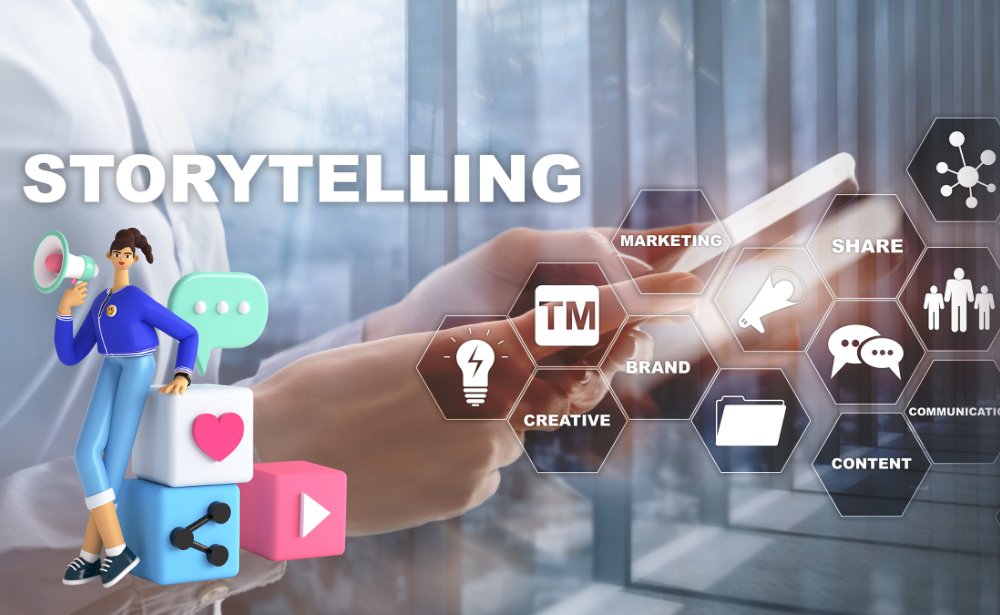Storytelling has always been a cornerstone of human communication, dating back to ancient times when it was used to share wisdom, culture, and values. But in today’s digital age, its relevance has only increased, especially in the realm of marketing. In a world saturated with content and advertising, it’s the compelling stories that break through the noise and resonate deeply with audiences.
In this blog post, we’ll explore how storytelling in marketing can create powerful emotional connections, help brands humanize their messaging, and ultimately drive customer loyalty. We will also cover practical strategies for crafting narratives that engage your audience, guiding them through your brand’s journey.
Table of Contents
Why Storytelling is So Powerful in Marketing
Humans are hardwired to respond to stories. When we hear a well-told story, it activates multiple areas of our brain, making the information more memorable. According to studies, stories can increase a message’s retention by up to 22 times compared to simple facts and figures.
For businesses, this means that marketing messages told through compelling stories have a much higher chance of leaving a lasting impact. But why is this?
1. Storytelling Humanizes Brands
At the heart of any great story is emotion. Whether it’s excitement, sadness, or joy, emotions connect us—and brands that successfully incorporate storytelling can evoke these feelings.
When you tell the story of your brand, your products, or the journey of solving a customer’s problem, you humanize your company. This process makes your brand more relatable and personable, allowing potential customers to connect with you on an emotional level. This emotional connection is critical for fostering trust and establishing long-term relationships.
2. Creating a Memorable Brand Identity
Stories are memorable. A brand that uses storytelling to share its mission, history, or values creates a distinct identity. For example, think of brands like Nike or Apple—both companies have built their brands around stories of innovation, struggle, and empowerment. They don’t just sell products; they sell an experience and a lifestyle, which is deeply embedded in their storytelling.
3. Building Emotional Connections
Stories give your audience something to relate to, especially when they address pain points or challenges your customers face. By aligning your narrative with the aspirations, dreams, or struggles of your audience, you create a bond that goes beyond transactional. When customers feel understood, they’re more likely to trust and remain loyal to your brand.
Key Elements of Compelling Storytelling in Marketing
Creating an impactful story isn’t just about telling any random tale. It requires structure, authenticity, and a deep understanding of your target audience. Here are the most essential elements for effective storytelling in marketing:
1. Know Your Audience
The first step to crafting a compelling story is understanding who you’re talking to. Ask yourself:
- What are their values and beliefs?
- What problems or challenges are they facing?
- What kind of emotional triggers resonate with them?
These questions will help you create stories that are relevant and meaningful to your audience. Personalization is key here—audiences today expect brands to understand their needs and tailor messages accordingly.
By addressing your audience’s pain points in your narrative, you’re more likely to grab their attention and drive action. For example, if your target audience is busy professionals struggling to find time for fitness, telling the story of someone who overcame similar hurdles by using your product can strike a chord.
2. Structure Your Story
Every great story has a clear beginning, middle, and end. This traditional story arc is a powerful tool in marketing as well. Here’s how you can apply it:
- Beginning: Set the stage and capture the audience’s attention. Introduce a character (often your customer or your brand) and present a problem or challenge they face.
- Middle: Build tension and suspense. In marketing terms, this is where you highlight the struggles and how difficult it was to find a solution. This keeps the audience engaged.
- End: Deliver a satisfying resolution—show how your product or service solved the problem, improved lives, or provided value. This is where you create a lasting impression, giving your audience a clear takeaway.
3. Incorporate Authenticity
One of the biggest mistakes brands make is trying to be something they’re not. Authenticity is key in brand storytelling. Customers can easily sense when a brand is not being genuine, and it can lead to distrust.
Make sure your stories align with your brand’s core values and mission. Share real experiences, real people, and real outcomes. For instance, if you’re a small local business, don’t try to come across as a big corporate entity. Instead, lean into your personal story and your connection with the community.

4. Visual Storytelling
Humans process visual content 60,000 times faster than text. In marketing, pairing your story with engaging visuals—whether through images, videos, or infographics—can significantly enhance your narrative. A well-crafted visual can evoke emotion and make your message more memorable.
For example, sharing customer testimonials through video storytelling is highly effective. Viewers can see the customer’s emotions, their expressions, and the transformation they’ve undergone—all of which are harder to convey through text alone.
5. Emotion Drives Action
Emotion is the driving force behind storytelling in marketing. It’s what moves people to take action, whether that’s making a purchase, signing up for a newsletter, or sharing your content. To evoke emotion, focus on human experiences that your audience can relate to.
For instance, if you sell eco-friendly products, you might tell the story of how your business was inspired by a desire to make the world a better place for future generations. This taps into the values of sustainability and environmental responsibility, which many customers care deeply about.
Examples of Storytelling in Marketing
Several brands have mastered the art of storytelling and successfully integrated it into their marketing strategies. Let’s explore some well-known examples:
1. Nike – “Just Do It” Campaign
Nike’s iconic “Just Do It” campaign is a classic example of emotion-driven storytelling. Instead of focusing on the technical features of their products, Nike tells the stories of athletes who push through challenges and achieve greatness. By doing this, they connect with customers on an emotional level, making their brand synonymous with perseverance and success.
2. Airbnb – “Belong Anywhere”
Airbnb uses stories from real customers to showcase how their platform helps travelers find unique and welcoming accommodations. By focusing on the personal experiences of hosts and guests, Airbnb creates an emotional bond with their audience, reinforcing their message of inclusivity and belonging.
3. Dove – “Real Beauty” Campaign
Dove’s “Real Beauty” campaign is another example of using storytelling to connect with the audience. By telling the stories of real women and challenging traditional beauty standards, Dove has been able to build a strong emotional connection with its customers.
How to Incorporate Storytelling into Your Marketing Strategy
Now that you understand the power of storytelling, let’s look at how you can incorporate it into your marketing strategy.
1. Share Your Brand’s Origin Story
Your origin story is the foundation of your brand. It answers questions like how and why your business was started. This can help customers relate to your brand and build a deeper connection with you.
2. Use Customer Testimonials
Your customers are your biggest advocates. Their stories can be incredibly powerful in marketing. Highlight their experiences with your brand to show how your products or services have positively impacted their lives.

3. Create a Series of Stories
Instead of relying on one-off stories, consider developing a series that dives deeper into different aspects of your brand. This allows you to keep your audience engaged over time and strengthens your relationship with them.
4. Leverage Social Media for Storytelling
Social media platforms are ideal for sharing stories in an engaging, real-time format. Whether through Instagram Stories, TikTok videos, or YouTube, these platforms allow you to connect directly with your audience and offer dynamic storytelling opportunities.
FAQs
1. Why is storytelling important in marketing?
Storytelling in marketing is important because it helps brands build emotional connections with their audience, making their messages more memorable and impactful. It humanizes the brand, fosters trust, and increases customer loyalty.
2. How do you structure a compelling story for marketing?
A compelling story in marketing should have a clear beginning, middle, and end. The beginning sets the stage, the middle builds suspense or tension, and the end offers a resolution that aligns with your brand message or solution.
3. How can visuals enhance storytelling?
Visuals enhance storytelling by making the content more engaging and easier to understand. They also evoke emotions more powerfully than text alone, helping to create a stronger connection with your audience.
4. Can small businesses benefit from storytelling?
Yes, small businesses can greatly benefit from storytelling. By sharing their unique journey, values, and the real stories of their customers, small businesses can build deeper relationships and differentiate themselves from larger competitors.
5. How can brands maintain authenticity in storytelling?
Brands can maintain authenticity by staying true to their core values and mission. Telling real stories, whether from the brand’s perspective or through customer testimonials, helps create a genuine and trustworthy image.
6. How does storytelling drive customer loyalty?
Storytelling drives customer loyalty by creating emotional bonds. When customers relate to a brand’s story or values, they are more likely to develop trust and stay loyal to the brand over the long term.







